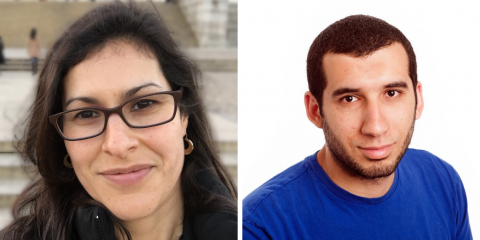 Ahmed Abdelfattah, who has a background in biochemistry and protein engineering, and Sonia Mayoral, a neuroscientist with a background in neuron-glial interactions, will become assistant professors in Brown University’s Department of Neuroscience. A multi-disciplinary search committee representing seven Carney-affiliated departments led the search.
Ahmed Abdelfattah, who has a background in biochemistry and protein engineering, and Sonia Mayoral, a neuroscientist with a background in neuron-glial interactions, will become assistant professors in Brown University’s Department of Neuroscience. A multi-disciplinary search committee representing seven Carney-affiliated departments led the search.
Abdelfattah is interested in engineering novel classes of light-responsive, genetically encoded tools for reading out and modulating brain activity at the resolution of individual cells. Mayoral is interested in neuronal-glial cell interactions and the role of myelination in neuroprotection such as during neurodegeneration.
“I am thrilled that we were successful in recruiting Sonia Mayoral and Ahmed Abdelfattah to Carney and to Brown, and I am also hugely grateful to the search committee which included representatives from seven departments” said Diane Lipscombe, Reliance Dhirubhai Ambani Director of the Carney Institute. “Sonia and Ahmed are truly exceptional scientists who will bring new ideas to tackling big questions in brain science, build new collaborations, and enrich the Carney community. We look forward to welcoming them to campus on January 1, 2021.”
Investigating neuron-glia interactions
Sonia Mayoral studies interactions between neurons and one type of glial cell, the oligodendrocyte, which makes myelin. Myelin greatly increases the speed at which axons conduct the electrical impulses they use to communicate to one another. However, Mayoral’s work is beginning to reveal new roles for myelin along axons, which involve the induction of local changes in the composition of the intercellular compartments of myelinated axonal regions.
“These local changes can affect the integrity and function of myelinated axons in a multitude of ways that I’m very excited to explore,” Mayoral said. “I’m interested in studying these first in the visual system, where I can genetically manipulate myelination along axons in the optic nerve. The Carney Institute has a very strong community of investigators who study the visual system and axonal proteins and their functions. Thus, it possesses the expertise and resources that my research program requires to thrive.”
Mayoral received a B.S. in biological sciences from San Jose State University in California and a Ph.D. in neuroscience from Stanford University. She conducted postdoctoral research at the University of California, San Francisco, where she developed a novel, genetic mouse model that allows spatial and temporal control of myelin deposition along axons in optic nerves.
At Brown, Mayoral will use this model to study the interactions between neurons and oligodendrocytes. She and the members of her lab will use biochemistry, imaging and genomic analysis to tackle this question. Mayoral will also use cell culture systems of neurons, as well as oligodendrocytes and other supporting cells, to tease apart the cellular and molecular mechanisms mediating the interactions among these cells. Mayoral’s research could illuminate mechanisms of neurodegeneration that may guide the development of new therapeutic strategies for neuroprotection.
“I chose Brown and the Carney Institute mainly because of the people. There is a team-like spirit there that I have yet to encounter anywhere else,” Mayoral said. “While getting the opportunity to pursue my own independent research program in an excellent academic setting is exciting enough, I'm really excited about how much further I can take that research and about discovering new directions for it, by joining a tight-knit and collaborative community of investigators in all areas of neuroscience.”
Developing molecular tools for cellular and systems neuroscience
Despite challenges of interviewing during the COVID-19 pandemic, Ahmed Abdelfattah was willing to take the leap with Brown. Why? Brown has an “amazing research environment,” he said.
“Brown and Carney foster an environment with no boundaries between different departments and research disciplines,” Abdelfattah said. “Experimentalists, engineers, theorists and clinicians work together towards a common goal. This collaborative and collegial environment is key especially in a rapidly evolving field like brain sciences. I don’t see this very often in other places.”
Abdelfattah received a B.S. in pharmacy and biotechnology from the German University in Cairo, Egypt, and a Ph.D. in chemistry from the University of Alberta in Canada, where he worked on the development of fluorescent protein-based indicators for neuronal activity imaging. At the University of Alberta, Abdelfattah was a Vanier Canada Scholar and recipient of the President’s Doctoral Prize of Distinction.
During his postdoctoral research at the Janelia Farm campus of the Howard Hughes Medical Institute, Abdelfattah engineered a new class of chemigenetic fluorescent voltage indicators, called Voltron. Voltron enables, for the first time, imaging of neural activity from dozens of living neurons simultaneously. Abdelfattah has distributed Voltron to hundreds of labs who are using it to image neural circuits in model organisms ranging from mice to zebrafish to flies.
At Brown, Abdelfattah will continue to develop molecular tools for cellular and systems neuroscience. He and his lab members will engineer proteins into new voltage sensors, neuropeptide sensors, and light-activated protein capsids for visualizing, tracing and manipulating brain circuits. These new tools will expand the ability to record, map and manipulate functionally connected neurons at unprecedented spatiotemporal resolution.
“I’ve already started talking with neuroscientists, engineers and data scientists to collaborate on multiple projects using different model organisms and imaging setups,” Abdelfattah said. “I anticipate that more interactions in the future with Brown’s wider research community will inspire additional directions for my lab’s protein engineering that will enable new biological insights.”